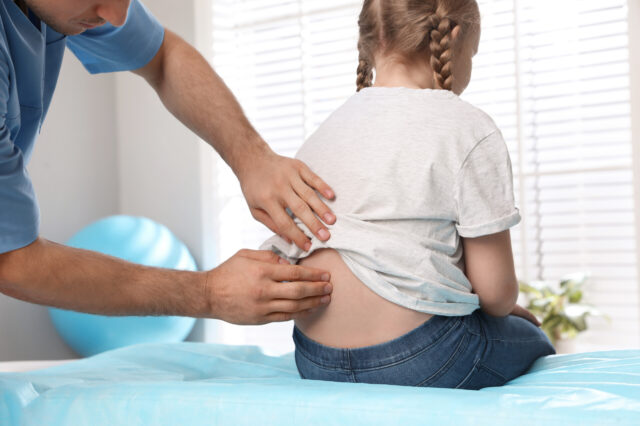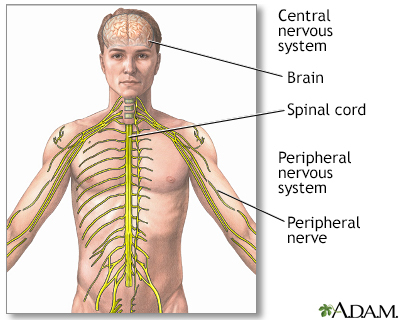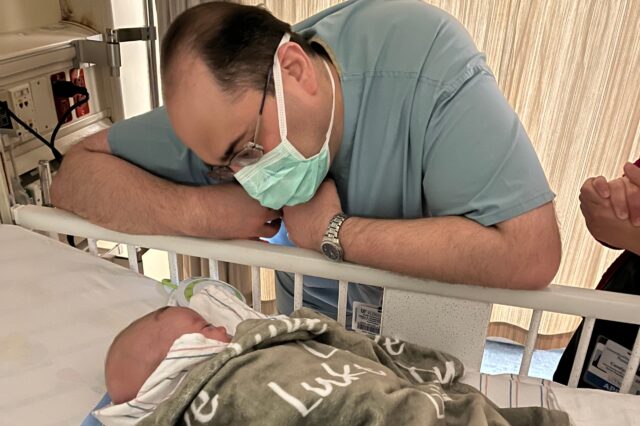Expert Insight for Understanding Scoliosis in Children
Scoliosis is a common condition of the spine, often found in children and young adolescents. Questions about the condition are among the most frequently asked…

Update your location to show providers, locations, and services closest to you.
Cerebral palsy (CP) is a group of disorders that can involve the brain. This affects nervous system functions, such as movement, learning, hearing, seeing, and thinking.
There are several different types of CP, including spastic, dyskinetic, ataxic, hypotonic, and mixed.

Spastic paralysis; Paralysis - spastic; Spastic hemiplegia; Spastic diplegia; Spastic quadriplegia
CP is caused by injuries or abnormalities of the brain. Most of these problems occur as the baby grows in the womb. But they can happen at any time during the first 2 years of life, while the baby's brain is still developing.
In some people with cerebral palsy, parts of the brain are injured due to a low level of oxygen (hypoxia) in those areas. It is not known why this occurs.
Premature infants have a slightly higher risk of developing CP. It may also occur in early infancy as a result of certain conditions such as:
In some cases, the cause of CP is never determined.
Symptoms of CP can be very different between people with this group of disorders. Symptoms may:
Symptoms are usually seen before a child is 2 years old. Sometimes symptoms begin as early as 3 months. Parents may notice that their child is delayed in reaching developmental stages such as sitting, rolling, crawling, or walking.
There are several different types of cerebral palsy. Some people have a mix of symptoms.
Spastic CP is the most common type. Symptoms include:
The following symptoms may occur in other types of CP:
Other brain and nervous system symptoms may include:
Eating and digestion symptoms:
Other symptoms:
The health care provider will perform a full neurologic exam. In older people, testing cognitive function is also important.
Other tests may be performed as needed, most often to rule out other disorders:
There is no cure for CP. The goal of treatment is to help the person be as independent as possible.
Treatment requires a team approach, including:
Treatment is based on the person's symptoms and the need to prevent complications.
Self and home care include:
Putting the child in regular schools is recommended unless physical disabilities or mental development makes this impossible. Special education or schooling may help.
The following may help with communication and learning:
Physical therapy, occupational therapy, orthopedic help, or other treatments may also be needed to help with daily activities and care.
Medicines may include:
Surgery may be needed in some cases to:
Shockwave therapy to reduce spasticity is being investigated.
Stress and burnout among parents and other caregivers of people with cerebral palsy is common. Seek support and more information from organizations that specialize in CP.
CP is a life-long disorder. Long-term care may be required. The disorder does not affect expected length of life. The amount of disability varies. Babies with mild CP may outgrow their symptoms.
Many adults are able to live in the community, either independently or with different levels of help.
CP may lead to the following health problems:
Call your provider if symptoms of CP develop, especially if you know that an injury occurred during birth or early infancy.
Getting the proper prenatal care may reduce the risk for some rare causes of CP. In most cases though, the injury causing the disorder is not preventable.
Pregnant mothers with certain medical conditions may need to be followed in a high-risk prenatal clinic.
Adults with CP should continue to follow with a neurologist to reduce the risk of late complications.

Greenberg JM, Haberman B, Narendran V, Nathan AT, Schibler K. Neonatal morbidities of prenatal and perinatal origin. In: Resnik R, Lockwood CJ, Moore TR, Greene MF, Copel JA, Silver RM, eds. Creasy and Resnik's Maternal-Fetal Medicine: Principles and Practice. 8th ed. Philadelphia, PA: Elsevier; 2019:chap 73.
Johnston MV. Encephalopathies. In: Kliegman RM, St. Geme JW, Blum NJ, Shah SS, Tasker RC, Wilson KM, eds. Nelson Textbook of Pediatrics. 21st ed. Philadelphia, PA: Elsevier; 2020:chap 616.
Kudva A, Abraham ME, Gold J, et al. Intrathecal baclofen, selective dorsal rhizotomy, and extracorporeal shockwave therapy for the treatment of spasticity in cerebral palsy: a systematic review. Neurosurg Rev. 2021;44(6):3209-3228. PMID: 33871733 pubmed.ncbi.nlm.nih.gov/33871733/.
Oskoui M, Shevell MI, Swaiman KF. Cerebral palsy. In: Swaiman KF, Ashwal S, Ferriero DM, et al, eds. Swaiman's Pediatric Neurology: Principles and Practice. 6th ed. Philadelphia, PA: Elsevier; 2017:chap 97.
Sidhu R, O'Banion D, Hall C. Autism and other developmental disabilities. In: Jankovic J, Mazziotta JC, Pomeroy SL, Newman NJ, eds. Bradley's and Daroff's Neurology in Clinical Practice. 8th ed. Philadelphia, PA: Elsevier; 2022:chap 90.
Smith SE, Gannotti M, Hurvitz EA, et al. Adults with cerebral palsy require ongoing neurologic care: a systematic review. Ann Neurol. 2021;89(5):860-871. PMID: 33550625 pubmed.ncbi.nlm.nih.gov/33550625/.
Verschuren O, Peterson MD, Balemans AC, Hurvitz EA. Exercise and physical activity recommendations for people with cerebral palsy. Dev Med Child Neurol. 2016;58(8):798-808. PMID: 26853808 pubmed.ncbi.nlm.nih.gov/26853808/.



Scoliosis is a common condition of the spine, often found in children and young adolescents. Questions about the condition are among the most frequently asked…

Almost 34 weeks into her pregnancy, Megan’s water broke. Panicked, knowing that she was about to deliver early, she was rushed to the hospital. It was not long…

People tend to think of cerebral palsy as a single disorder. Actually, the term refers to a group of conditions that share two common factors — they interfere with muscular coordination, and their...
Pregnant women have enough to worry about as their due date...